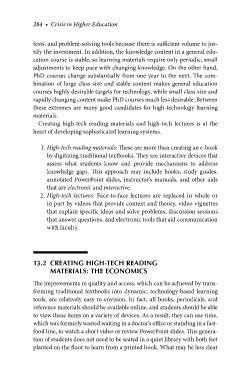Page 314 - Crisis in Higher Education
P. 314
284 • Crisis in Higher Education
tests, and problem-solving tools because there is sufficient volume to jus-
tify the investment. In addition, the knowledge content in a general edu-
cation course is stable, so learning materials require only periodic, small
adjustments to keep pace with changing knowledge. On the other hand,
PhD courses change substantially from one year to the next. The com-
bination of large class size and stable content makes general education
courses highly desirable targets for technology, while small class size and
rapidly changing content make PhD courses much less desirable. Between
these extremes are many good candidates for high-technology learning
materials.
Creating high-tech reading materials and high-tech lectures is at the
heart of developing sophisticated learning systems.
1. High-tech reading materials: These are more than creating an e-book
by digitizing traditional textbooks. They are interactive devices that
assess what students know and provide mechanisms to address
knowledge gaps. This approach may include books, study guides,
annotated PowerPoint slides, instructor’s manuals, and other aids
that are electronic and interactive.
2. High-tech lectures: Face-to-face lectures are replaced in whole or
in part by videos that provide context and theory, video vignettes
that explain specific ideas and solve problems, discussion sessions
that answer questions, and electronic tools that aid communication
with faculty.
13.2 CREATING HIGH-TECH READING
MATERIALS: THE ECONOMICS
The improvements in quality and access, which can be achieved by trans-
forming traditional textbooks into dynamic, technology-based learning
tools, are relatively easy to envision. In fact, all books, periodicals, and
reference materials should be available online, and students should be able
to view these items on a variety of devices. As a result, they can use time,
which was formerly wasted waiting in a doctor’s office or standing in a fast-
food line, to watch a short video or review PowerPoint slides. This genera-
tion of students does not need to be seated in a quiet library with both feet
planted on the floor to learn from a printed book. What may be less clear

